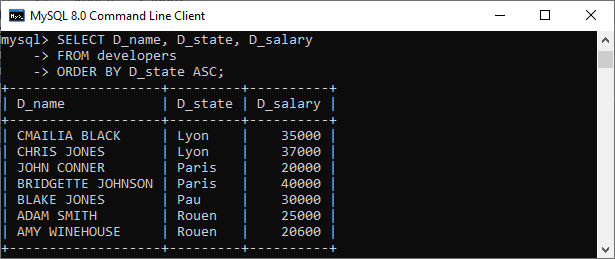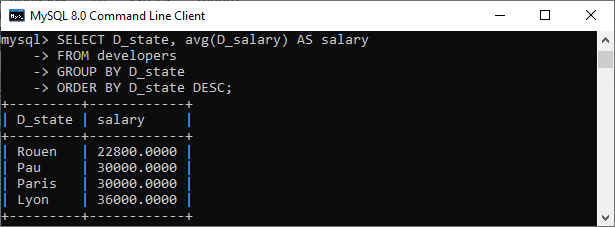-
SQL Tutorial
SQL Database
SQL Table
- what-is-table
- sql-create-table
- sql-drop-table
- sql-delete-table
- sql-rename-table
- sql-truncate-table
- sql-copy-table
- sql-temp-table
- sql-alter-table
SQL Select
- select-statement
- sql-select-unique
- sql-select-distinct
- sql-select-count
- sql-select-top
- sql-select-first
- sql-select-last
- sql-select-random
- sql-select-as
- sql-select-in
- sql-select-multiple
- sql-select-date
- sql-select-sum
- sql-select-null
SQL Clause
SQL Order By
SQL Insert
SQL Update
SQL Delete
- delete-statement
- sql-delete-table
- sql-delete-row
- sql-delete-all-rows
- delete-duplicate-rows
- sql-delete-database
- sql-delete-view
- sql-delete-join
SQL Join
SQL Keys
Difference
SQL Injection
Misc
- sql-formatter
- sql-group-by
- sql-add/drop/update-column-operation
- sql-cast-function
- sql-comments
- sql-concat-function
- cte-sql
- how-to-use-distinct-in-sql
- joining-three-or-more-tables-in-sql
- what-is-web-sql
- how-to-create-functions-in-sql
- how-to-run-sql-script
- how-to-delete-duplicate-rows-in-sql
- nth-highest-salary
- 12-codd's-rules
- sql-except
- types-of-sql-join
SQL MCQ
PL/SQL Tutorial
Interview
GROUP BY vs. ORDER BYThis article explains the complete overview of the GROUP BY and ORDER BY clause. They are mainly used for organizing data obtained by SQL queries. The difference between these clauses is one of the most common places to get stuck when learning SQL. The main difference between them is that the GROUP BY clause is applicable when we want to use aggregate functions to more than one set of rows. The ORDER BY clause is applicable when we want to get the data obtained by a query in the sorting order. Before making the comparison, we will first know these SQL clauses.  ORDER BY ClauseThe ORDER BY clause is used in SQL queries to sort the data returned by a query in ascending or descending order. If we omit the sorting order, it sorts the summarized result in the ascending order by default. The ORDER BY clause, like the GROUP BY clause, could be used in conjunction with the SELECT statement. ASC denotes ascending order, while DESC denotes descending order. The following is the syntax to use the ORDER BY clause in a SQL statement: Let us understand how the ORDER BY clause works with the help of the following example. Suppose we have a table developer that contains the following data:  We can see that these results are not displayed in an organized way. Suppose we want to organize results in ascending or descending order based on the state column. In that case, we would need the ORDER BY command to get the desired result. We can do this by executing the command as follows: Here is the output where we will get the desired results:  GROUP BY ClauseThe GROUP BY clause is used in SQL queries to organize data that have the same attribute values. Usually, we use it with the SELECT statement. It is always to remember that we have to place the GROUP BY clause after the WHERE clause. Additionally, it is paced before the ORDER BY clause. We can often use this clause in collaboration with aggregate functions like SUM, AVG, MIN, MAX, and COUNT to produce summary reports from the database. It's important to remember that the attribute in this clause must appear in the SELECT clause, not under an aggregate function. If we do so, the query would be incorrect. As a result, the GROUP BY clause is always used in conjunction with the SELECT clause. The query for the GROUP BY clause is grouped query, and it returns a single row for each grouped object. The following is the syntax to use GROUP BY clause in a SQL statement: Let us understand how the GROUP BY clause works with the help of an example. Here we will demonstrate it with the same table. Suppose we want to know developer's average salary in a particular state and organize results in descending order based on the state column. In that case, we would need both the GROUP BY and ORDER BY command to get the desired result. We can do this by executing the command as follows: This query initially formed an intermediate result that has grouped the state. Next, the AVG function is performed on each group of states, then sort the result in descending order, and finally, we will get the desired results as shown below:  Key Differences between GROUP BY and ORDER BYThe following are the key distinctions between the Group By and Order By clause:
GROUP BY vs. ORDER BY Comparison ChartThe following comparison chart explains their main differences in a quick manner:
ConclusionThe GROUP BY and ORDER BY clauses are compared in this article. Both clauses are extremely useful SQL database features. When we want to form a group of rows, we use the GROUP BY clause. If we want to organize data in ascending or descending order based on a particular column, we use the ORDER BY clause. They do not have any relationship because both are used for two different purposes. However, we can combine them to serve some special purpose or can use them individually depending on the circumstances. We can use these clauses only with the SELECT statement. Next TopicWHERE vs HAVING
|